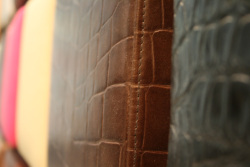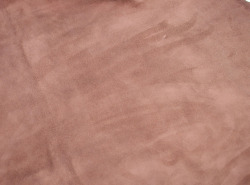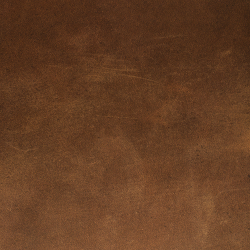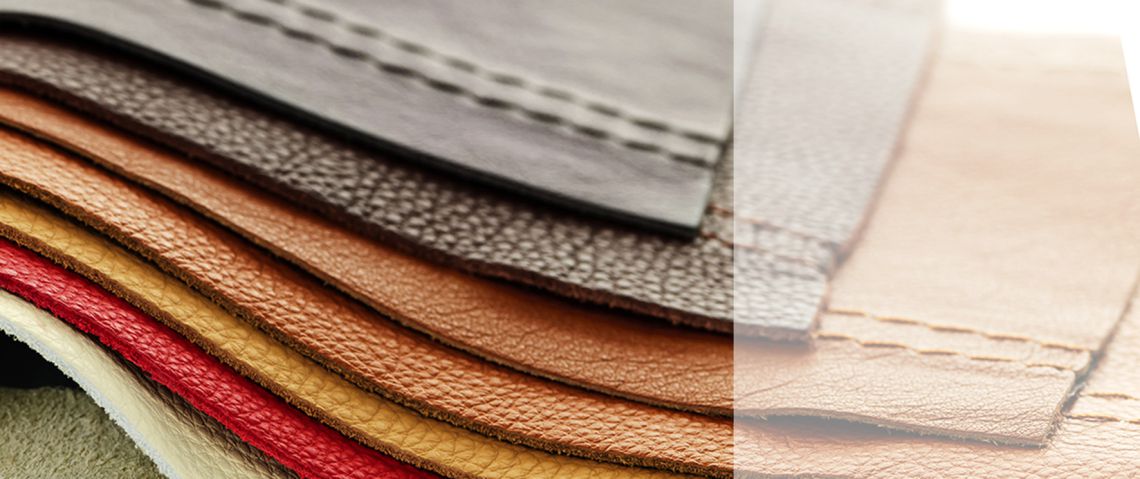- Home
- Upholstered furniture
- Leather
- Leather types
How can the different types of leather be distinguished between reliably?
A basic distinction is made between SMOOTH LEATHER and SUEDE LEATHER.
The outer surface of the animal hide is used for smooth leather. Despite the name smooth leather, the surface is not "as smooth as an eel" – rather, you can see the hide texture and the pores, and also any individual marks such as thorn scratches and skin folds are also recognisable.
With SUEDE LEATHER, however, the surface is sanded, roughened. This is done to conceal hide damage and also to make use of split animal hides. Colloquially, suede leather is often referred to as suede, nubuck or velour.
Why is it called smooth leather, even though you can see the hide structure?
Smooth leather is the collective term for all types of leather that are made from the "grain side" of the animal's rawhide. That is to say on the outer surface, out of which for example, the fur grows on a cow. Although it is called smooth leather, the appearance may be structured, grained, smooth or embossed, depending on the type of final finishing (e.g. by coating, embossing, colouring, etc.).

This is also smooth leather, here with artificial crocodile embossing.
Are there different types of smooth leather?
Depending on the type of dyeing and refinement, smooth leather can be divided into three large leather groups: Along with untreated, superior pure aniline leathers there are also the pigmented, easy-to-care-for leathers. The happy medium between these two types is semi-aniline leather, which can be described as being practically untreated, and yet suitable for everyday use.
The differences in brief: After dyeing, pure aniline remains untreated; semi-aniline is given a surface colouring with pigment colours, and pigmented leather is covered with a thicker to very thick coating of colour.
This sounds complicated, but it means nothing more than that these criteria can be used to find the right leather for every taste and every possible application.
The quality of the raw hides determines why some hides are used to make pure aniline, while others become pigmented leather. If the animal's skin is free of scars and flaws, it will retain the typical leather character and be used for untreated pure aniline leather. If, on the other hand, a skin has a large number of irritating scars, they are often covered with a layer of colour. Depending on the thickness of the colour layer, the leather is called either semi-aniline or covered/pigmented leather. In the case of low-quality skins, manufacturers even go as far as to artificially re-emboss the structure of the leather, because the actual skin structure is no longer visible after the application of the colour.
PIGMENTED / COVERED LEATHER – the easy-to-care-for leather
Robust, suitable for everyday use, easy to care for and uncomplicated.
Pigmented leathers are coated with an additional colour pigment layer after the tanning and dyeing process. The pores, the individual skin appearance as well as scars and other individual characteristics of the cow skin completely disappear under this layer of colour.
Some pigmented leathers are therefore even embossed with an artificial scar pattern in order to imitate the skin structure.
These leathers have a slightly stiffer, moderately warm feel. They can therefore be slightly cool on cold days, because body heat cannot penetrate. On hot summer days, on the other hand, you will tend to perspire, and the leather feels sweaty.
But this surface treatment also offers a high protection against stains, because liquids can not penetrate deep into the leather.
Due to the high durability, this type of leather is "very suitable for everyday use" and less likely to fade. It is very easy to clean, and practically any stain can be removed ideally with the appropriate KERALUX® cleaners
SEMI-ANILINE – the happy medium
Supple, pleasant, protected.
Semi-aniline is given a light colouring in addition to the dyeing processes.
It thus becomes more durable and easier to clean, without losing its softness or smoothness.
The skin pores are still slightly visible (using a magnifying glass), as is its natural origin, which reveals itself in irregular graining and small healed wounds.
Semi-aniline is the happy medium between untreated pure aniline leathers and pigmented leathers with a thicker coating of colour.
It combines the best of these two worlds: It is soft and full-grained, and yet provides some protection against stains and fluids.
p>PURE ANILINE – the exclusive
Original, untreated, elegant, high quality. Leather with a fully unique character.
It is fully impregnated with dye, but otherwise largely natural. The individual skin pores are still very clearly visible as hair-thin holes.
If you rub your fingernail along the surface, it will leave a "trace", but this polishes itself out again through daily use.
Since only flawless and scar-free hides can be used, which are rare, purely aniline-dyed leathers are much more expensive than pigmented leathers.
Its natural, untreated surface makes it very soft, warm and sensually pleasing.
The open skin pores allow a high level of breathability.The leather adapts to body temperature in no time.
Due to the untreated surface, pure aniline is unfortunately very sensitive and prone to stains and signs of wear. It develops an individual character over time, this "patina" adds to the charm of aniline leathers
As is so often the case in life, there are also two sides of the coin with smooth leather:> The finest, the most natural pure aniline leather is unfortunately also the most sensitive. Which is also a question of taste. Because leather connoisseurs in particular, who sing the praises of these valuable natural leathers, are happy to accept that the naturalness leaves its mark on these leathers. They do not find the patina which forms on aniline leathers over time as disturbing, but as an expression of the individual character of the leather.
SUEDE LEATHER, also called nubuck, velour or suede, is characterised by a soft, velvety surface. This effect is achieved by roughening the surface or underside of the split leather hide. The roughened, velvety surface of this type of leather rules out applying a layer of dye after barrel dyeing, because the fibres would stick together. Suede leather feels very supple and warm. It is recognisable by the so-called "writing effect", i.e. if you stroke the nubuck leather with your hand, you will see the "stroke direction" as the direction of the roughened fibres changes:
It is interesting to note that leathers with the designation "SUEDE LEATHER" are actually made from the hides of wild animals such as roe deer and red deer etc. Due to the natural behaviour of the animals in the wild, the hide surface is heavily scarred, which is why in most cases the underside of the hide (the flesh side) is used, roughed and made into a velour leather. Did you know that?

Other leather types:
Saddle leather: Belongs to the smooth leather types and denotes leather with a very smooth and slightly waxed surface. Saddle leather is characterised by a pleasant, warm and waxy feel.
Leather with a vintage effect:
 |
Smooth leather or polished leather, which is given an antique look by applying a wax layer or a so-called effect finish. This makes the surface look lively and a little "old-fashioned". |
Vegetable/plant-tanned leather: Leather tanned with various plant-based (vegetable) tannins (such as oak bark or fruits), which is then further processed to create the usual different types of leather, usually aniline leather.
Foil-coated leathers are leathers coated with a polyurethane film (hence colloquially often called PU leather) and have a shiny, antique surface. Often however, this leather is not declared as being split leather when it is sold.
Pull-up leather: Smooth or nubuck leathers that have been treated with an oil, grease or wax finish on the leather surface are referred to as pull-up leathers. In most cases, furniture shows pronounced signs of use/wear even in the showroom; this "patina" is, however, typical and intended. Warning, likelihood of confusion: pull-up leather and plastic-coated leather (colloquially, PU leather).
The designation PU leather is a designation which is not allowed due to competition law for imitation leather or PU-coated split leather.
Are you still unsure which type of leather is used on your upholstered furniture? You can find this out with absolute certainty by looking for the manufacturer's precise designation. We have listed all of the most popular leather types used by upholstered furniture manufacturers in our database. Click on your manufacturer in the FURNITURE MANUFACTURERS field above and determine the precise leather designation. You will then be shown the appropriate cleaning and care products specially tailored to this type of leather.
More tips for determining the type of leather you have with certainty:
Tip No. 1: Have a look on the invoice for your upholstered furniture – you will usually find information from the manufacturer here.
Tip No. 2: Call your furniture store, stating your purchase contract number - they can normally find out with certainty the exact leather material used.
If neither of these approaches are successful, we will gladly help you and find out together exactly what type of leather you have over the telephone: +49 7251 / 9625-0!

